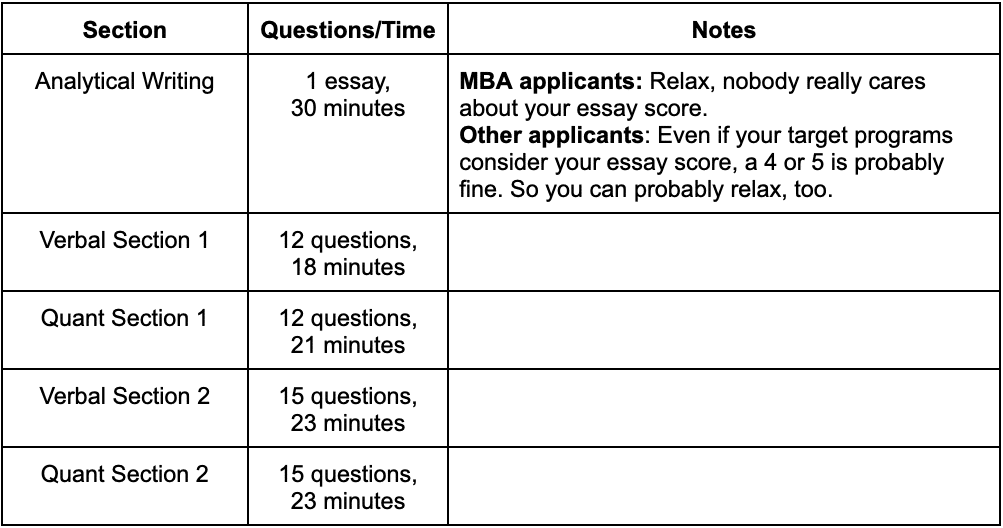
What is GRE test day like?
UPDATED IN 2024 FOR THE NEW GRE
When you take the GRE in a test center, you’ll spend roughly 2.5 hours in the facility, thanks in part to lengthy check-in and security procedures. To prevent stress and mishaps, you’ll want to review the GRE’s test-day procedures several days before your exam.
Additionally, you now have the option to take the GRE either at home or in a test center. In this article, we’ll focus on the test center experience first, and then we’ll discuss the differences between the at-home and test center versions of the GRE.
Keep reading to help determine whether the at-home or test center GRE exam is best for you.
How to prepare for test day in a GRE exam center
To minimize stress, distractions, and mishaps on test day, we recommend doing all of the following a few days before your GRE exam in a test center:
- Plan out what you need to bring to the test center, including:
- Comfortable clothing without accessories (e.g., no jewelry, watches, etc).
- An ID that meets ETS requirements
- Snacks for your break
- Plan out your route to the test center. How long will it take you to arrive? Get there at least 30 minutes before your test is scheduled to begin.
- Double-check your appointment details (location, date, and time). This might sound silly, but we’ve seen plenty of students show up to the test center on the wrong day – or even in the wrong city.
What happens during the GRE check-in process
If you’re taking the GRE in a test center, here’s how the check-in process works:
- Arrive about 30 minutes before your appointment time.
- Usually, you’ll notify someone at the test center that you’ve arrived, and they’ll give you a scintillating pamphlet of rules to review. You’ll also provide your ID at this time.
- You’ll also likely be assigned a locker in which to store your snacks and other personal items.
- They may provide a bag for your phone and other electronic devices – do NOT unseal this bag until you are completely done with your test.
- When your appointment time approaches, you’ll be photographed in order to verify your identity.
- This is when the steamy security measures will begin. You may be asked to turn out your pockets, to pat yourself down, to pull up your sleeves and pant legs, and to scan your palm or finger. You may also be scanned with a metal detector, or be subjected to whatever new security protocols they’ve cooked up.
- Finally, you’ll be led to your testing room.
And that’s when the real fun begins.
STARTING YOUR GRE EXAM IN A TEST CENTER
A proctor will bring you to your workstation – often featuring an old, clunky desktop computer – and sign you in.
The GRE proctor will also provide you with a booklet of laminated scratch paper and two wet-erase markers.
We recommend that you quickly test the markers before your exam begins. If the markers don’t work, raise your hand to alert the proctor.
TAKING THE GRE
The GRE consists of five sections with no break. The Analytical Writing section is always first, but after that the two quant and two verbal sections can appear in any order.
Here’s an example:

AFTER YOU FINISH YOUR GRE EXAM
Before you’ve seen your score, you’ll have the option to cancel your test, but it almost never makes sense to cancel your score at the test center (you really have no idea how well you’ve done!), so just click past this option.
Your quant and verbal scores will then pop up on the screen.
Congratulations, you’re finished! Raise your hand to exit the test room, collect any items from your locker, and then leave the test center.
You’ll receive your official GRE score report in 10-15 days.
Roughly 15 days after your exam, you’ll have access to the free GRE Diagnostic Service report in your ETS account. This service provides detailed information on the types and difficulty levels of the questions you missed. If you plan to retake the GRE, we strongly recommend analyzing this report to identify ways to improve your performance.
AT-HOME GRE: WHAT TO EXPECT ON TEST DAY
Thanks to the wonders of COVID-19, you can now take the GRE online, from the comfort of your own home.
The GRE exam itself is identical, regardless of whether you take it at home or in the test center, but there are some differences in the test-day experience if you choose to take the at-home GRE instead of the test center GRE.
Here’s what to expect on the at-home GRE exam:
Preparing for the at-home GRE test
To minimize stress, distractions, and mishaps on test day, we recommend doing all of the following a few days before your at-home GRE exam:
- Make sure that your computer meets the equipment requirements.
- Complete the browser download and equipment check.
- Find a space that meets the environment and testing space requirements.
- Purchase a small whiteboard, erasable marker, and whiteboard eraser.
- Choose comfortable clothing without accessories (e.g., no jewelry, watches, etc).
- Make sure that you have an ID that meets ETS requirements.
- Plan snacks for your break.
- Double-check your appointment details (date and time).
Check-in process for the at-home GRE (about 20 minutes)
At your appointment time, click the “Start Your Test” link in your appointment confirmation email.
Select “start session,” and complete the steps that your proctor dictates. You’ll have to show your ID to the proctor, and he or she will ask you to show your computer screen using a mirror or phone camera. The proctor will also ask you to use your computer camera to show the room you’re working in.
The proctor will then launch your test.
Taking the at-home GRE test
The proctor will watch you throughout the whole test, and may contact you verbally or in a chat window if there are any issues. For example, if he/she can’t see your face as you work, you may be instructed to shift positions.
The sections on the at-home GRE are exactly the same as the sections on the test center GRE.
At the end of the at-home GRE test
Before you’ve seen your scores, you’ll have the option to cancel them. Again, it almost never makes sense to cancel your score on test day (you really have no idea how well you’ve done!), so just click past this option.
Your quant and verbal scores will then pop up on the screen.
Congratulations, you’re done! Follow the proctor’s instructions to erase your whiteboard and close out of the test.
You will receive your official score report in 10-15 days, and you’ll have access to the GRE Diagnostic Service in approximately 15 days.
WANT TO LEARN MORE ABOUT THE GRE?
- What is the GRE, anyway? And what skills does the GRE measure?
- More articles on the basics of the GRE
- How to approach GRE Reading Comprehension, Text Completion, and Sentence Equivalence
- Everything you need to know about GRE tutoring
- How to choose between the GMAT and GRE
- Our free, complete GRE video course